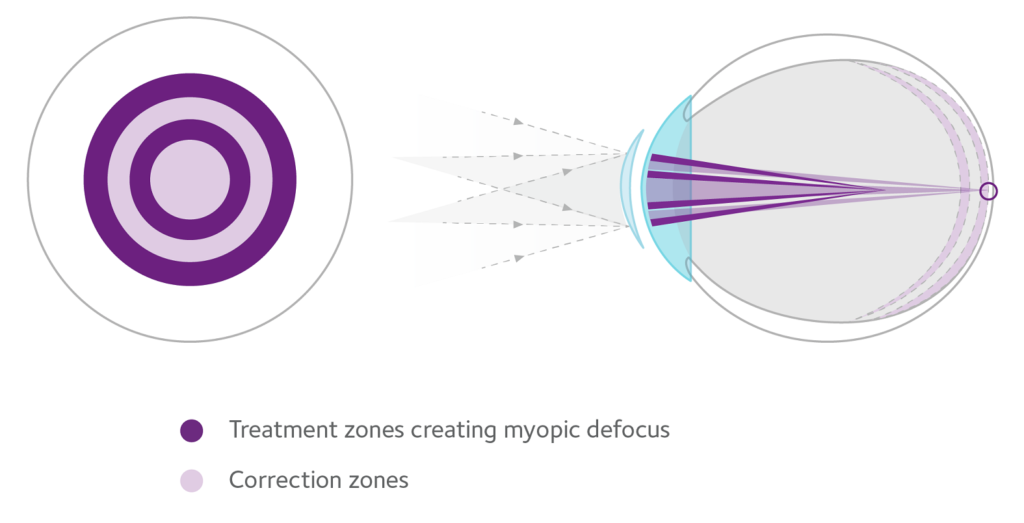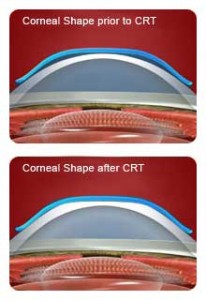MYOPIA CONTROL
Childhood myopia (nearsightedness) rates are increasing, with 1 in 3 children now affected. Multiple studies show myopia becoming much more common in children, showing up at earlier ages and progressing more rapidly. Many researchers believe reduced outdoor time and increased screen time on devices are part of the problem. Myopia often leads to struggles in school and activities for your child due to poor vision, as well as increased eye disease risks.
Higher levels of myopia significantly increase your child’s risks for serious eye diseases, like retinal disease and glaucoma. Early intervention is key to slow or even stop the progression of myopia in your child. There are now non-surgical treatments to improve your child’s vision and reduce their long-term eye health risks associated with myopia.
Here are the most effective options, which our office is happy to help you with:
-
Soft daily contact lens (MiSight 1 Day): MiSight lenses work by utilizing an optic zone concentric ring design with alternating vision correction and treatment zones. Two zones are vision correction zones with the label power of the contact lens, and the alternating two zones are treatment zones with 2 diopters of defocus to slow the progression of myopia. After three years of studies, the lenses slowed myopia progression by an average of 59% and slowed the rate at which the eye lengthens by an average of 52% compared to children in the control group.

-
Corneal Reshaping Therapy (CRT): CRT uses retainer lenses, with a material similar to gas permeable contact lenses, that have custom designs that reshape the front surface of the eye. There are two huge advantages to CRT. First, the retainer lenses are worn only while sleeping, and typically no glasses or other contacts are used during the day. This is very exciting for your child! No glasses or contacts are needed during the day for great vision! Secondly, CRT is the most effective treatment for controlling myopia. Studies show a decrease in the progression of nearsightedness by 60-100% with this treatment. This treatment involves multiple visits with our doctors and specialty, custom-made retainer lenses.

We are so excited to offer these alternatives to our young nearsighted patients. There is absolutely nothing wrong with traditional glasses or contact lenses, but these new options give us the power to control how much prescription your child will develop over the years.
Call to set up a comprehensive eye exam where you can talk with our doctors about your children’s options to control their myopia!
Dangers of Myopia
Researchers now know there is more to worry about with myopic eyes than the inconvenience of thicker lenses.
Myopic patients are more vulnerable to a range of sight-threatening diseases and complications.
- More than 50 percent of retinal detachments not related to trauma are associated with myopia.
- Other myopia risks include glaucoma, cataracts and macular degeneration.
- Patients with mild myopia have a four-fold increase in the risk of retinal detachment.
- For those with moderate to severe myopia, the risk increases 10 times.
More on CRT
CRT (short for corneal refractive therapy) is a nonsurgical procedure using specially designed contact lenses to gently reshape the curvature of the eye to improve vision. CRT lenses were FDA approved in June 2002 and hundreds of thousands of people, worldwide, are enjoying them This therapeutic contact lens gently and safely reshapes the cornea while you sleep to correct nearsightedness (myopia). Most commonly referred to as “Corneal Reshaping”, CRT offers a safe, non-invasive, non-surgical procedure that temporarily corrects nearsightedness up to -6.00 diopters, and mild amounts of astigmatism. CRT is also known as orthokeratology, or OrthoK.
How CRT works
Who is a good candidate for CRT?
If you are one of the billions of people in the world who are nearsighted and you want the freedom from your daytime contacts or glasses then CRT may be a great option for you! If you’re one of the many individuals who experience dry eye or contact lens discomfort, CRT may be the treatment option for you. In fact, many successful CRT patients were previous soft lens wearers. If you experience dry eye, LASIK may not be an appropriate option, making CRT an excellent alternative. It temporarily eliminates the need for daytime contacts or glasses and is a nonsurgical alternative for patients who prefer a less permanent treatment option. Those with less than -6.00 diopters of nearsightedness and less than -1.50 diopters of astigmatism would be considered good candidates.
There are no age restrictions with CRT – Making it a perfect option for kids!
Recent studies suggest that 75% of children are capable of wearing corneal reshaping lenses. CRT Brand Contact Lenses are worn at night and could be a perfect treatment option to correct your child’s nearsightedness (myopia). Imagine your child getting up in the morning to go to school and instead of putting on daytime contact lenses, they remove them and see clearly all day long. No lost contact lenses. No broken glasses. No hassles. Just great vision!
What Studies Have Been Done?
Visit the manufacturer’s page for a list of a few clinical studies that have been conducted here.
Testimonial
“The lenses have helped me see more clearly day to day and are great since they only have to be worn at night. I got used to them quickly!” – A.N.
“The CRT lenses have improved my son’s vision over a short period of time. They are convenient since they only need to be worn at night. CRT is a great substitute for glasses!” – L.N.

No Glasses. No Daytime Contacts. No Surgery. No Kidding!
How are the lenses inserted and removed?
There is a very helpful short video that can help your child learn how to properly insert and remove the lenses here.